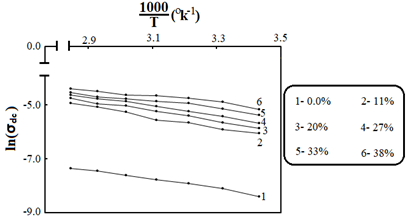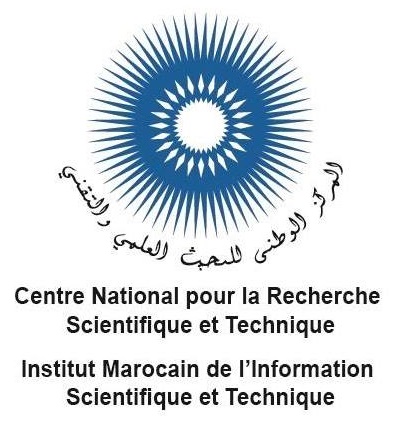The Study of the evolution of certain electrical properties of a carboxymethyl cellulose by irradiating it and adding different concentrations of materials at different temperatures
Keywords:
Current density , Electric field , Activation energy , Irradiation, NanoparticlesAbstract
There are two parts to this manuscript. In the first part, thin films were prepared by doping carboxymethyl cellulose with Polyanionic cellulose low viscosity, with a concentration of 73% CMCHV and 27% PACLV, then CMC HV/PAC LV thin films were exposed to different X-ray photon doses (0, 200, 400, 600, and 800 cGy). But second Part were prepared the thin films by dissolving 8 g of CMCHV in 50 ml of distilled water, then adding NaCl and ZnONPs in concentrations (0.00, 11, 20, 27, 33 and 38%). The intensity of the direct current I was measured for all samples by changing the potential difference V at different temperatures (T).
The measurement results of all samples studied in this research indicate that the conductivity and current density increase with an increase in the X-ray photon doses in the irradiated samples or with an increase in the concentrations of NaCl, ZnOPNs and also increases with increasing temperature, but the conductivity and current density increase more when NaCl is added than when ZnO PNs are added. By using these results, several areas can benefit, such as industry, scientific research, etc.
Downloads
References
M. B. Heaney,” Electrical Conductivity and Resistivity”, electrical measurement, signal processing, and
displays, Ed John G.webster. CRC predd, 2003. https://www.researchgate.net/publication/309188334_Electrical_Conductivity_and_Resistivity
A. J. Heeger, et al.,” Conductive polymers”, The Royal Swedish Academy of Sciences has decided to award the
Nobel Prize in Chemistry for 2000 to three scientists who have revolutionised the development of electrically
conductive polymers.
https://www.nobelprize.org/uploads/2018/06/advanced-chemistryprize2000.pdf
A. Mora, et al.,” Electrical conductivity of CNT/polymer composites: 3D printing, measurements and modeling”,
Elsevier, Composites Part B: Engineering Vol. 183, 107600, February 2020,.
https://doi.org/10.1016/j.compositesb.2019.107600
Sara Lafuerza, et al.,” New reflections on hard X-ray photon-in/photon-out spectroscopy”,
https://pubs.rsc.org/de-ch/content/getauthorversionpdf/D0NR01983F
B. L. H. Azari, et al.,” The Study of The Electrical Conductivity and Activation Energy on Conductive
Polymer Materials”, Computational and Experimental Research in Materials and Renewable Energy, Vol. 4,
pp. 71-79,. 2021 DOI : 10.19184/cerimre.v4i2.28371
Liao et al.,” Experiments: (2) Faraday Ice Pail Topic Introduction”, Topics: Capacitors Related Reading: Course
Notes, Sections 4.3-4.4; Chapter 5. https://ocw.mit.edu/courses/8-02-physics-ii-electricity-and-magnetism-
spring-2007/3db0d6aa49a807ad07f978b511a3bf60_summary_w04d2.pdf
J.L. Davidson, et al., “Predicted EIT current densities in the brain using a 3D anatomically realistic model of
the head”, Hermann Scharfetter, Robert Merva (Eds.): Icebi ifmbe Proceedings 17, pp. 376–379, 2007.
www.springerlink.com © Springer-Verlag Berlin Heidelberg 2007
S. Hughes,” Lecture 7: Current, continuity equation, resistance, Ohm’s law”, Massachusetts Institute of
Technology Department of Physics.(2005). https://web.mit.edu/sahughes/www/8.022/lec07.pdf
A. T. Coyle, et al., “Comparison of Linear Temperature Corrections and Activation Energy
Temperature Corrections for Electrical Resistivity Measurements of Concrete”, Advances in Civil Engineering
Materials, Vol. 7, 2018. doi:10.1520/ACEM20170135
J. Jack, et al., " Spectroscopy of polymers", Elsevier Science Inc. Now York, USA.Second edition(1999)
M.J. Roberts, et al.,” Chemistry for peptide and protein PEGylation”, Advanced Drug Delivery Reviews 54
(2002) 459–476. DOI: 10.1016/s0169-409x(02)00022-4
J. Tao,” Effects of Molecular Weight and Solution Concentration on Electrospinning of PVA”, A thesis
submitted to the Faculty of the Worcester polytechnic Institute, 7-23, 2003.
P. Kim, et al., " Fabrication of nanostructures of polyethylene glycol for applications to protein adsorption and
cell adhesion", InstItute of physics publishiNg nanotechnology, vol. 16, pp.1-7, 2005.
http://dx.doi.org/10.1088/0957-4484/16/10/072
S. A. Nouh, et al., “Thermal, Structural, and Optical properties of ?- irradiated poly(vinylcohol)/ poly(
ethylene glycol) thin Film”, Journal of Applied polymer Science, pp. 1-7, 2011. DOI:10.1002/app.35010
[ 15 ] E. Y. Wu, et al.,” The Schottky emission effect: A critical examination of a century-old model” Journal of
applied physics, 132, 025105,2022. https://doi.org/10.1063/5.0087909
X. G. Tang, et al.,” Leakage current and relaxation characteristics of highlyÑ111Ö-oriented leadcalcium
titanate thin films”, Journal of Applied Physics, American Institute of Physics. Vol. 94, 2003.
DOI: 10.1063/1.1611627
M.H. Makled et al.,” Electrical conduction and dielectric relaxation in p-type PVA/CuI polymer composite”,
Journal of Advanced Research, vol. 4, pp. 531–538, 2013.
A. D. Susilawati, et al.,” Polymer Film Blend of Polyvinyl Alcohol, Trichloroethylene and Cresol Red for
Gamma Radiation Dosimetry”, polymers, vol. 13, 1866, 2021. https://doi.org/10.3390/polym13111866
Y. S. Kim, et al.,” The Influence of Surface Roughness on the Electric Conduction Process in Amorphous
Ta2O5 Thin Films”, Journal of The Electrochemical Society, vol. 146, pp. 3398-3402, 1999.
J. Melai, et al.,” The electrical conduction and dielectric strength of SU-8", Journal of
micromechanics and microengneering, vol. 19, pp.7, 2009.
doi:10.1088/0960-1317/19/6/065012
A. R. Jabur,” Effect of polyaniline on the electrical conductivity andactivation energy of electrospun nylon
films”, International Journal of Hydrogen Energy, Vol. 43, PP. 530-536, 2018.
https://doi.org/10.1016/j.ijhydene.2017.04.005
M. V.F. Heinz, et al.,” Grain size effects on activation energy and conductivity: Na-?-alumina ceramics and
ion conductors with highly resistive grain boundary phases”, Acta Materialia, Vol. 213, 116940,2021.

Downloads
Published
How to Cite
Issue
Section
License
Copyright (c) 2024 Najla Ali

This work is licensed under a Creative Commons Attribution 4.0 International License.
Copyright on any article in the International Journal of Engineering and Applied Physics is retained by the author(s) under the Creative Commons license, which permits unrestricted use, distribution, and reproduction provided the original work is properly cited.
License agreement
Authors grant IJEAP a license to publish the article and identify IJEAP as the original publisher.
Authors also grant any third party the right to use, distribute and reproduce the article in any medium, provided the original work is properly cited.














